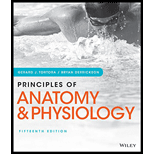
Concept explainers
To review:
The Scrotum's role in regulating the temperature of testes.
Introduction:
Scrotum is an organ, which participates and is involved in reproduction process of the males. It is made up of testes, epididymis, and spermatic cords. The sperms are produced by testes and stored in epididymis till maturity. Scrotum's role is to protect the testes and regulate the temperature of the testes so that the sperm could be protected and mature before discharge.
Explanation of Solution
The scrotum is located outside the pelvic cavity and this location of the scrotum helps it in changing the distance between abdomen and testicles and thus maintaining the temperature of the testes. The temperature regulation is possible by expansion and contraction of the scrotum muscles fibers. The temperature required for normal sperm production is almost 1–8°C less than the normal body temperature. Variation in the temperature of the scrotum affects the sperm production and maturity.
When the temperature around is warm, the scrotum muscles, cremaster, and dartos expand, this expansion helps to dissipate the heat. Whereas when the temperature around is cold, scrotal muscles contracts and moves more toward body wall and becomes tight to reduce the heat loss and absorb heat from the body. This maintains the temperature of the testes by contraction and expansion of the scrotal muscles.
Thus, it can be concluded that the scrotum maintains the temperature present in the testes through process of expansion and contraction of the scrotum muscles.
Want to see more full solutions like this?
Chapter 28 Solutions
Principles of Anatomy and Physiology
- please fill in the empty sports, thank you!arrow_forwardIn one paragraph show how atoms and they're structure are related to the structure of dna and proteins. Talk about what atoms are. what they're made of, why chemical bonding is important to DNA?arrow_forwardWhat are the structure and properties of atoms and chemical bonds (especially how they relate to DNA and proteins).arrow_forward
- The Sentinel Cell: Nature’s Answer to Cancer?arrow_forwardMolecular Biology Question You are working to characterize a novel protein in mice. Analysis shows that high levels of the primary transcript that codes for this protein are found in tissue from the brain, muscle, liver, and pancreas. However, an antibody that recognizes the C-terminal portion of the protein indicates that the protein is present in brain, muscle, and liver, but not in the pancreas. What is the most likely explanation for this result?arrow_forwardMolecular Biology Explain/discuss how “slow stop” and “quick/fast stop” mutants wereused to identify different protein involved in DNA replication in E. coli.arrow_forward
- Molecular Biology Question A gene that codes for a protein was removed from a eukaryotic cell and inserted into a prokaryotic cell. Although the gene was successfully transcribed and translated, it produced a different protein than it produced in the eukaryotic cell. What is the most likely explanation?arrow_forwardMolecular Biology LIST three characteristics of origins of replicationarrow_forwardMolecular Biology Question Please help. Thank you For E coli DNA polymerase III, give the structure and function of the b-clamp sub-complex. Describe how the structure of this sub-complex is important for it’s function.arrow_forward
 Human Physiology: From Cells to Systems (MindTap ...BiologyISBN:9781285866932Author:Lauralee SherwoodPublisher:Cengage Learning
Human Physiology: From Cells to Systems (MindTap ...BiologyISBN:9781285866932Author:Lauralee SherwoodPublisher:Cengage Learning Concepts of BiologyBiologyISBN:9781938168116Author:Samantha Fowler, Rebecca Roush, James WisePublisher:OpenStax College
Concepts of BiologyBiologyISBN:9781938168116Author:Samantha Fowler, Rebecca Roush, James WisePublisher:OpenStax College Human Biology (MindTap Course List)BiologyISBN:9781305112100Author:Cecie Starr, Beverly McMillanPublisher:Cengage Learning
Human Biology (MindTap Course List)BiologyISBN:9781305112100Author:Cecie Starr, Beverly McMillanPublisher:Cengage Learning





